Abstract
Immunohistochemical antibody techniques for detection of oestrogen receptors (ER) were applied to formalin fixed, paraffin embedded sections from 62 primary breast cancers, the metastases of their original regional lymph nodes (29 cases), bone marrow carcinosis (43 cases) and liver metastases (20 cases). Forty per cent of the primary tumours and 31% of the regional lymph node metastases were ER positive; in contrast, less than 20% of liver and bone marrow metastases were ER positive. The ER status of regional lymph node metastases was concordant with that of the primary tumour in 90% of the cases. The concordance rate was 75% for liver metastases and 58% for bone metastases. Patients with ER positive primary tumours had recurrence significantly more often in bone; ER negative tumours recurred more often in the liver. The survival after recurrence (SAR) was significantly related to the ER status of the primary tumour and to that of the regional lymph node metastases. In contrast, the SAR was not associated with the ER status of bone marrow carcinosis or liver metastases. Cox analyses showed that age and ER status of the primary tumour were the most important independent prognostic factors compared to other clinical, therapeutic, pathoanatomical and biochemical features. The study supports the hypothesis that tumour cell clones with different ER content are selected and adapted to grow in various anatomical sites. Moreover, the ER status of the primary tumour seems to be more important for the prognosis than the ER status of bone and liver metastases.
Full text
PDF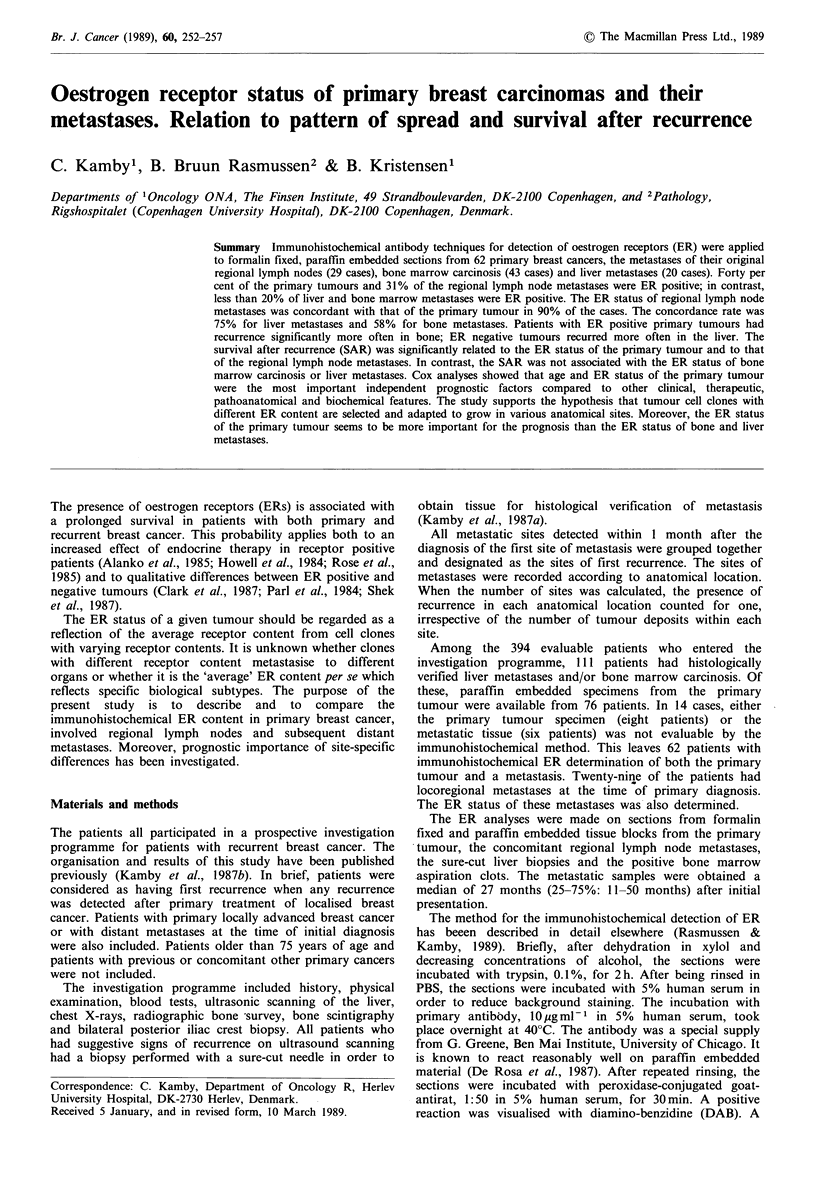
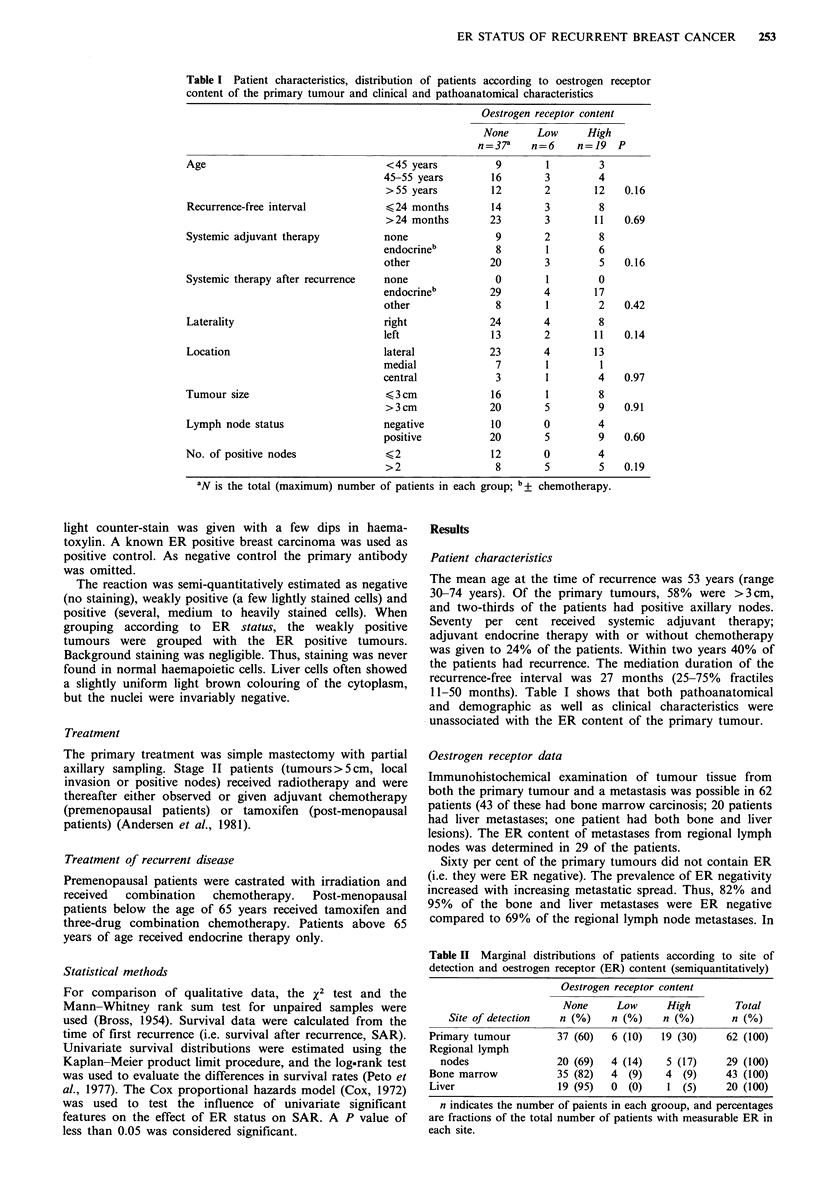
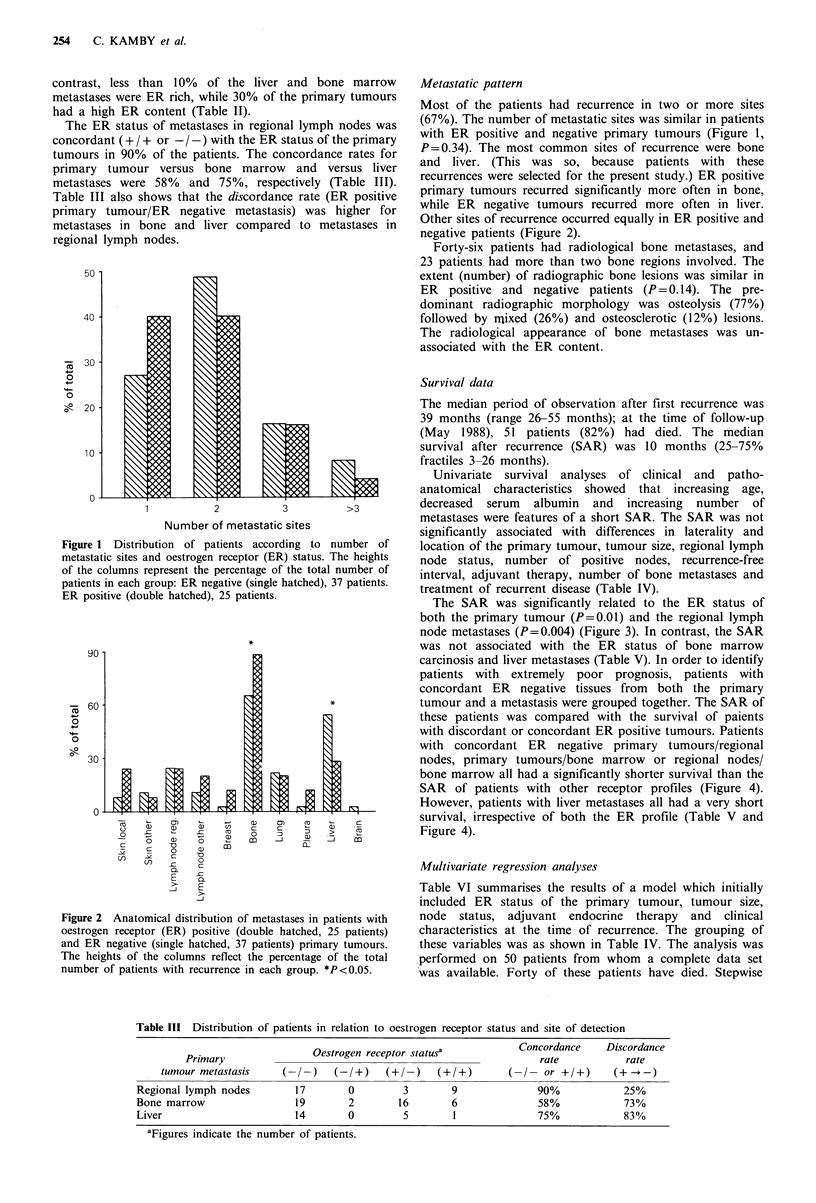
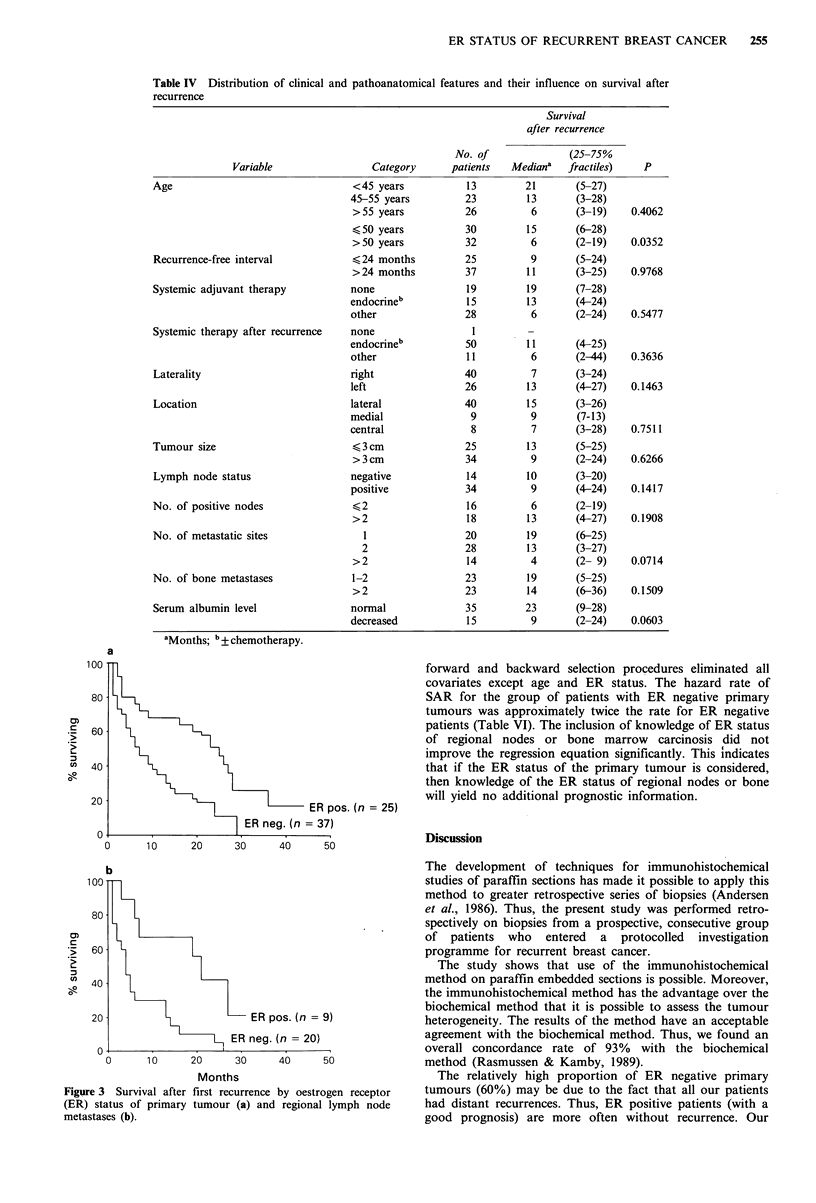
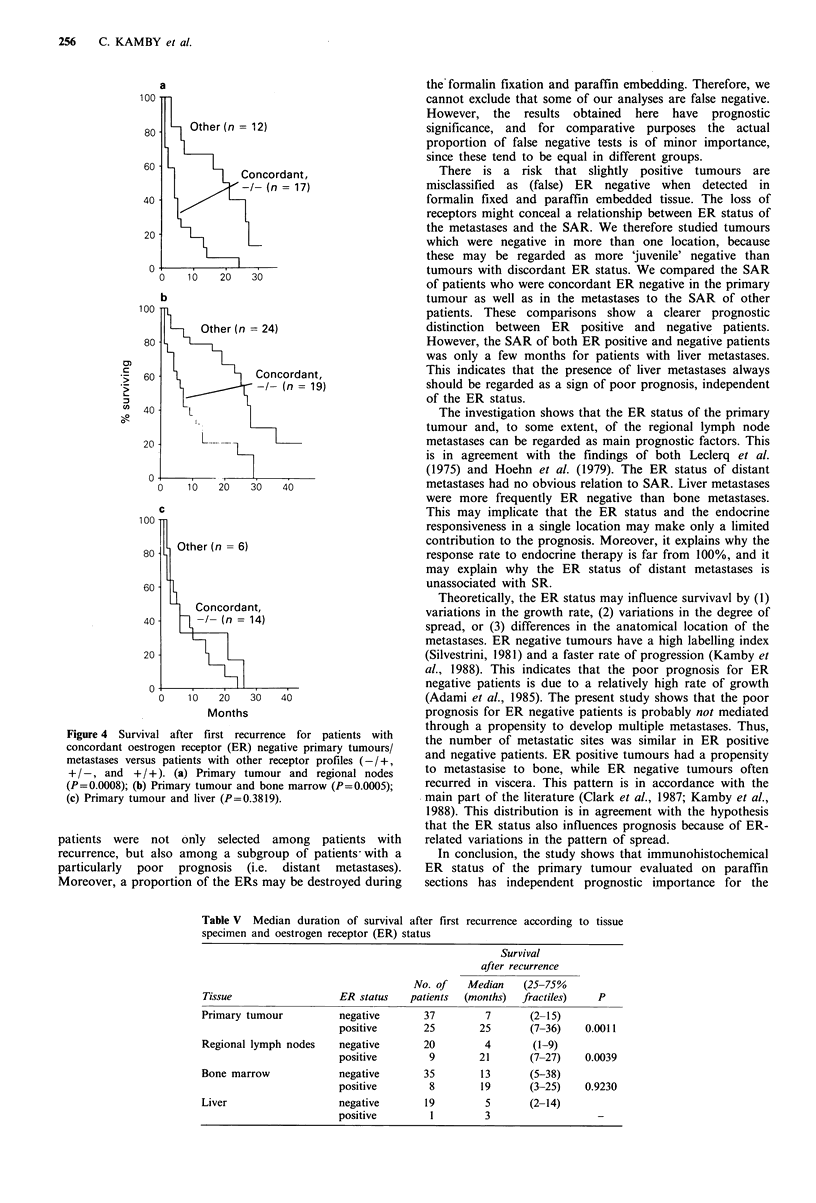
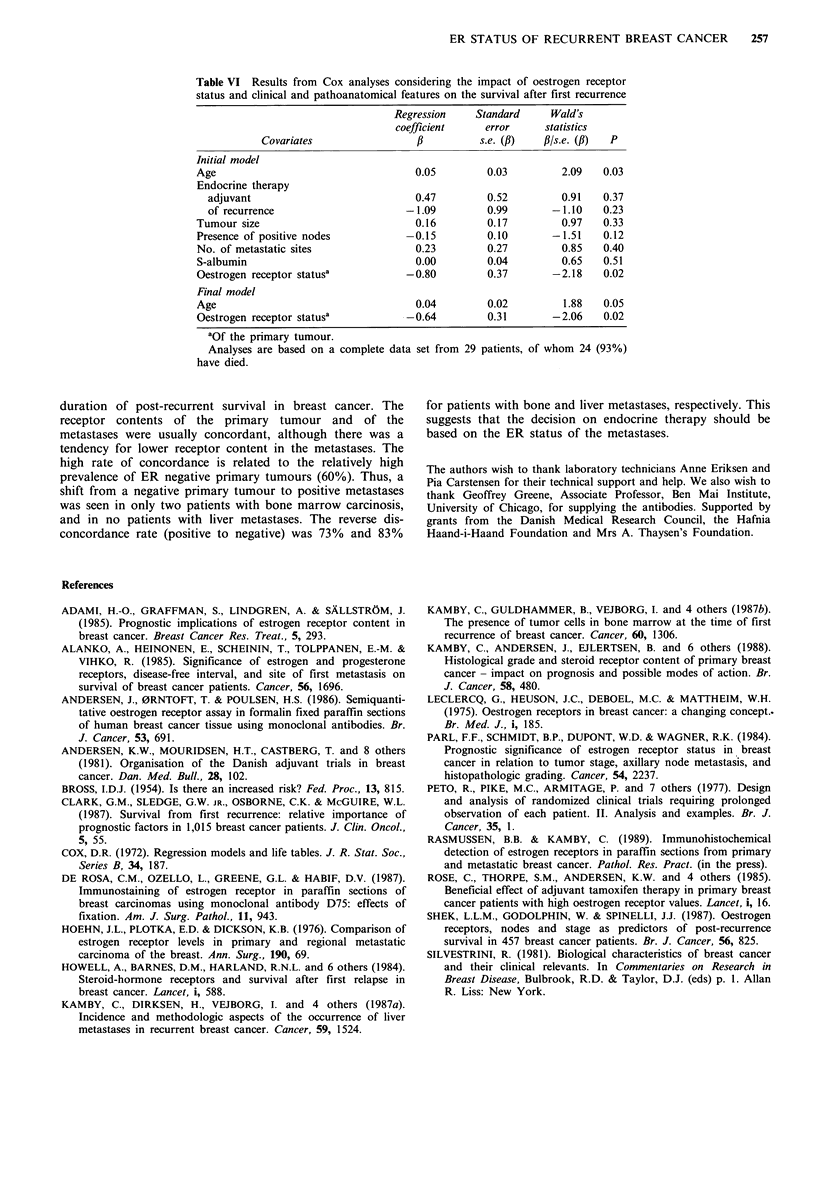
Selected References
These references are in PubMed. This may not be the complete list of references from this article.
- Adami H. O., Graffman S., Lindgren A., Sällström J. Prognostic implication of estrogen receptor content in breast cancer. Breast Cancer Res Treat. 1985;5(3):293–300. doi: 10.1007/BF01806024. [DOI] [PubMed] [Google Scholar]
- Alanko A., Heinonen E., Scheinin T., Tolppanen E. M., Vihko R. Significance of estrogen and progesterone receptors, disease-free interval, and site of first metastasis on survival of breast cancer patients. Cancer. 1985 Oct 1;56(7):1696–1700. doi: 10.1002/1097-0142(19851001)56:7<1696::aid-cncr2820560738>3.0.co;2-n. [DOI] [PubMed] [Google Scholar]
- Andersen J., Orntoft T., Poulsen H. S. Semiquantitative oestrogen receptor assay in formalin-fixed paraffin sections of human breast cancer tissue using monoclonal antibodies. Br J Cancer. 1986 May;53(5):691–694. doi: 10.1038/bjc.1986.114. [DOI] [PMC free article] [PubMed] [Google Scholar]
- Andersen K. W., Mouridsen H. T., Castberg T., Fischerman K., Andersen J., Hou-Jensen K., Brincker H., Johansen H., Henriksen E., Rørth M. Organisation of the Danish adjuvant trials in breast cancer. Dan Med Bull. 1981 Aug;28(3):102–106. [PubMed] [Google Scholar]
- BROSS I. D. Is there an increased risk? Fed Proc. 1954 Sep;13(3):815–819. [PubMed] [Google Scholar]
- Clark G. M., Sledge G. W., Jr, Osborne C. K., McGuire W. L. Survival from first recurrence: relative importance of prognostic factors in 1,015 breast cancer patients. J Clin Oncol. 1987 Jan;5(1):55–61. doi: 10.1200/JCO.1987.5.1.55. [DOI] [PubMed] [Google Scholar]
- De Rosa C. M., Ozzello L., Greene G. L., Habif D. V. Immunostaining of estrogen receptor in paraffin sections of breast carcinomas using monoclonal antibody D75P3 gamma: effects of fixation. Am J Surg Pathol. 1987 Dec;11(12):943–950. doi: 10.1097/00000478-198712000-00004. [DOI] [PubMed] [Google Scholar]
- Hoehn J. L., Plotka E. D., Dickson K. B. Comparison of estrogen receptor levels in primary and regional metastatic carcinoma of the breast. Ann Surg. 1979 Jul;190(1):69–71. doi: 10.1097/00000658-197907000-00015. [DOI] [PMC free article] [PubMed] [Google Scholar]
- Howell A., Barnes D. M., Harland R. N., Redford J., Bramwell V. H., Wilkinson M. J., Swindell R., Crowther D., Sellwood R. A. Steroid-hormone receptors and survival after first relapse in breast cancer. Lancet. 1984 Mar 17;1(8377):588–591. doi: 10.1016/s0140-6736(84)90995-4. [DOI] [PubMed] [Google Scholar]
- Kamby C., Andersen J., Ejlertsen B., Birkler N. E., Rytter L., Zedeler K., Thorpe S. M., Nørgaard T., Rose C. Histological grade and steroid receptor content of primary breast cancer--impact on prognosis and possible modes of action. Br J Cancer. 1988 Oct;58(4):480–486. doi: 10.1038/bjc.1988.245. [DOI] [PMC free article] [PubMed] [Google Scholar]
- Kamby C., Dirksen H., Vejborg I., Daugaard S., Guldhammer B., Rossing N., Mouridsen H. T. Incidence and methodologic aspects of the occurrence of liver metastases in recurrent breast cancer. Cancer. 1987 Apr 15;59(8):1524–1529. doi: 10.1002/1097-0142(19870415)59:8<1524::aid-cncr2820590823>3.0.co;2-9. [DOI] [PubMed] [Google Scholar]
- Kamby C., Guldhammer B., Vejborg I., Rossing N., Dirksen H., Daugaard S., Mouridsen H. T. The presence of tumor cells in bone marrow at the time of first recurrence of breast cancer. Cancer. 1987 Sep 15;60(6):1306–1312. doi: 10.1002/1097-0142(19870915)60:6<1306::aid-cncr2820600624>3.0.co;2-x. [DOI] [PubMed] [Google Scholar]
- Leclercq G., Heuson J. C., Deboel M. C., Mattheiem W. H. Oestrogen receptors in breast cancer: a changing concept. Br Med J. 1975 Jan 25;1(5951):185–189. doi: 10.1136/bmj.1.5951.185. [DOI] [PMC free article] [PubMed] [Google Scholar]
- Parl F. F., Schmidt B. P., Dupont W. D., Wagner R. K. Prognostic significance of estrogen receptor status in breast cancer in relation to tumor stage, axillary node metastasis, and histopathologic grading. Cancer. 1984 Nov 15;54(10):2237–2242. doi: 10.1002/1097-0142(19841115)54:10<2237::aid-cncr2820541029>3.0.co;2-v. [DOI] [PubMed] [Google Scholar]
- Shek L. L., Godolphin W., Spinelli J. J. Oestrogen receptors, nodes and stage as predictors of post-recurrence survival in 457 breast cancer patients. Br J Cancer. 1987 Dec;56(6):825–829. doi: 10.1038/bjc.1987.298. [DOI] [PMC free article] [PubMed] [Google Scholar]


